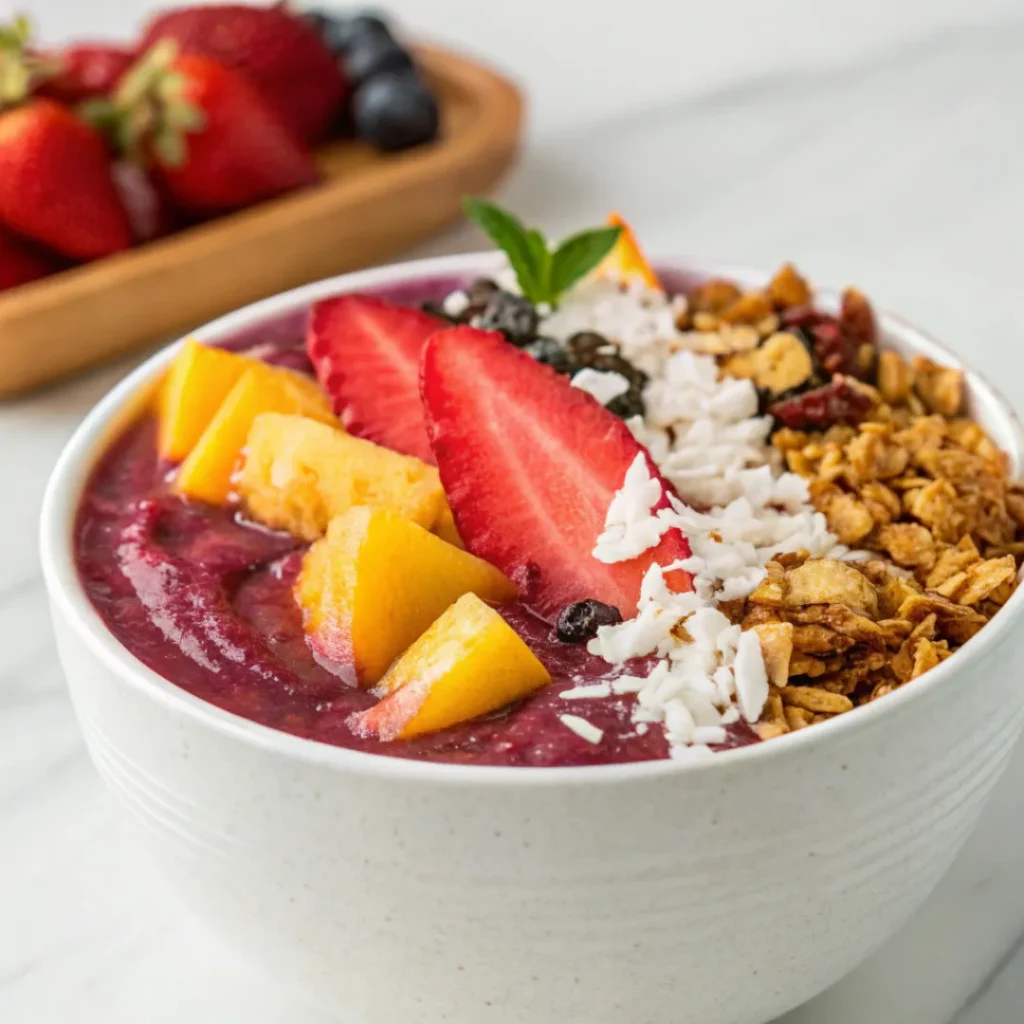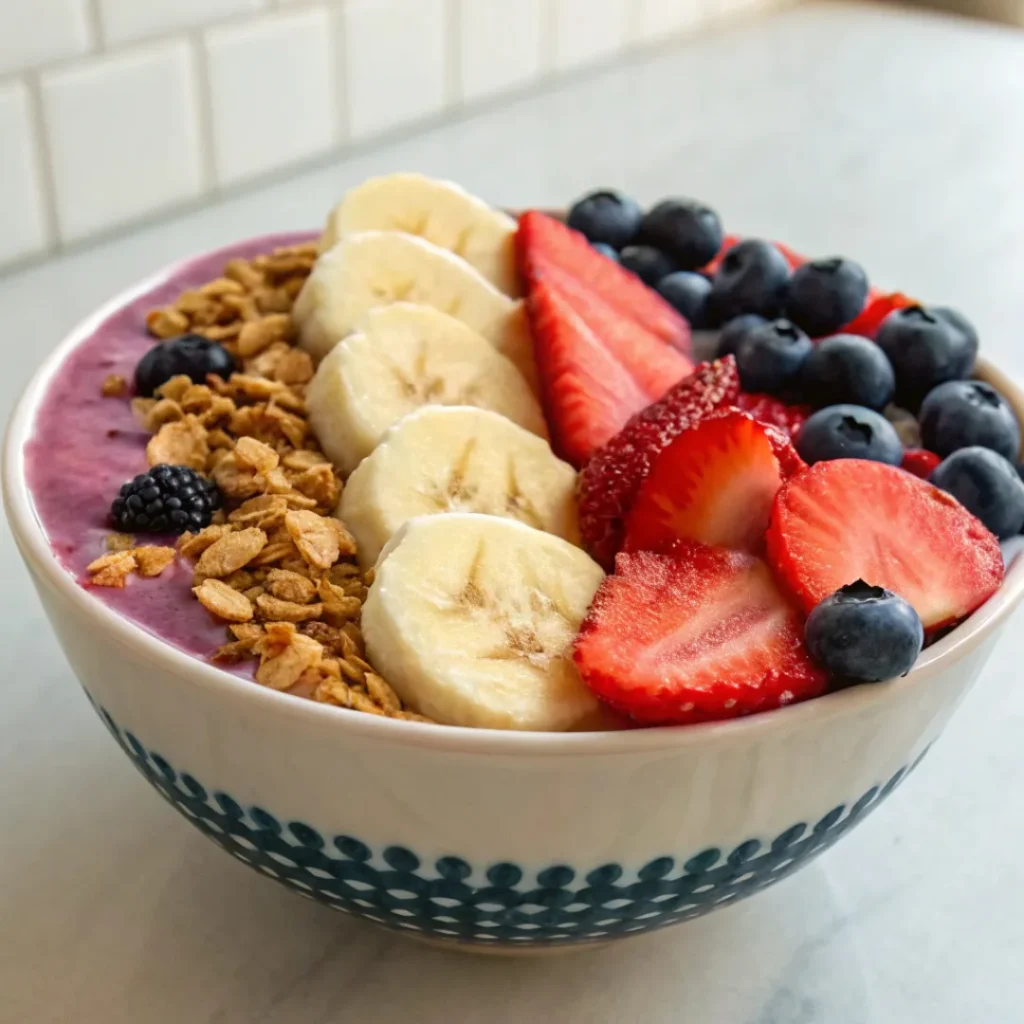Acai bowls and smoothie bowls have taken the food world by storm with their vibrant colors, rich flavors, and nutritious ingredients. Both options make for satisfying meals or snacks that are delicious, filling, and packed with a variety of nutrients. But what’s the difference between an acai bowl and a smoothie bowl? Despite their similarities, these two popular options are distinct in keyways, from ingredients and preparation to flavor profiles and health benefits.
In this guide, we’ll break down the difference between acai bowl and smoothie bowl, covering their ingredients, nutritional content, health benefits, and popular variations.
What Are Acai Bowls and Smoothie Bowls?
Both acai bowls and smoothie bowls are delicious, nutrient-dense options typically served in a bowl and eaten with a spoon. They’re made by blending fruits with a small amount of liquid, creating a thick, creamy texture that’s ideal for adding a variety of toppings like fresh fruits, nuts, seeds, and granola. The primary difference lies in their base ingredients.
Acai Bowl: An acai bowl is made with acai berries as the main ingredient, often in the form of frozen acai puree or acai powder.
Smoothie Bowl: A smoothie bowl, on the other hand, doesn’t include acai berries as a central ingredient. Instead, it can be made from a variety of fruits, vegetables, and liquids, depending on the desired flavor and nutrient profile.
Each type of bowl has a unique taste, appearance, and nutritional profile, making them versatile for different preferences and needs.
Key Ingredient: The Acai Berry
The acai berry is the distinguishing ingredient in an acai bowl, giving it a unique flavor, color, and nutritional boost. Native to the Amazon rainforest, acai berries are small, dark purple berries with a mildly tart and earthy taste. Known for their high antioxidant content, acai berries are rich in nutrients like:

- Antioxidants: Help protect cells from damage by free radicals.
- Healthy Fats: Acai berries contain small amounts of healthy fats, which can help keep you feeling fuller.
- Fiber: Supports digestion and helps promote satiety.
The high antioxidant content is one reason acai bowls are often touted as a superfood meal option. Smoothie bowls, however, can use a wide range of fruits, each with its own health benefits.
What Sets Acai Bowls Apart
Acai bowls are distinctive in several ways, primarily due to the acai berry. Here’s what makes an acai bowl unique:
- Rich Purple Color: The acai berry gives the bowl a deep, vibrant purple color.
- Earthy, Tart Flavor: The taste of acai is slightly tart and less sweet than many other fruits, creating a unique flavor profile.
- Nutrient Density: Acai bowls are celebrated for their high antioxidant content, thanks to the acai berry.
Acai bowls typically include blended fruits like bananas, blueberries, or strawberries to boost flavor and add natural sweetness.
Smoothie Bowls: Ingredients and Variations
Unlike acai bowls, smoothie bowls can be made with almost any fruit or vegetable, offering endless possibilities in terms of flavor, color, and nutritional value. Common ingredients for smoothie bowls include:

- Fruits: Bananas, berries, mangoes, pineapples, and kiwis are popular choices.
- Vegetables: Spinach, kale, or avocado can be added for extra nutrients without overpowering the flavor.
- Liquid Base: Smoothie bowls often use almond milk, coconut water, or other plant-based milks to blend the ingredients.
Smoothie bowls are highly customizable and can cater to different flavor preferences, from tropical to berry-rich or even chocolate-based options.
Comparing Nutritional Benefits
Both acai bowls and smoothie bowls offer substantial nutritional benefits, though they differ slightly due to their base ingredients.
Acai Bowls: Known for their antioxidant-rich properties, acai bowls provide essential nutrients that support cellular health and fight inflammation. They also contain small amounts of healthy fats and fiber, making them a filling option.
Smoothie Bowls: The nutritional value of a smoothie bowl depends on the ingredients. For example, a berry-based smoothie bowl is high in vitamin C and antioxidants, while a tropical smoothie bowl with pineapple and mango is rich in vitamin A and bromelain, an enzyme known to aid digestion.
Both bowls provide a good amount of fiber, vitamins, and minerals, making them nutrient-dense options.
Differences in Flavor and Texture
The flavor and texture of acai bowls and smoothie bowls vary based on their ingredients:
Acai Bowls: Acai berries contribute a mildly tart, earthy taste that pairs well with sweet fruits like bananas and strawberries. Acai bowls tend to have a smooth, thick consistency, almost like sorbet.
Smoothie Bowls: These bowls can range in flavor, from tropical and fruity to rich and creamy. Their texture varies depending on the ingredients used, but they are typically thick and spoonable, similar to a soft smoothie.
The unique flavors allow both types of bowls to cater to different taste preferences and mood.
How to Customize Acai and Smoothie Bowls
One of the best parts about both types of bowls is their versatility. Here are ways to customize each:
Acai Bowls: Try blending acai with different fruits, such as bananas, strawberries, and blueberries, for varied flavors.
Smoothie Bowls: Experiment with ingredients like spinach, avocado, or even cacao powder to create unique flavor profiles.
Customizing allows you to tailor each bowl to your nutritional needs and preferences, making them both enjoyable and functional.
Popular Toppings for Each Bowl
Toppings add flavor, texture, and additional nutrients to acai and smoothie bowls. Here are some popular toppings:
Acai Bowl Toppings: Fresh berries, sliced bananas, granola, coconut flakes, and chia seeds are commonly used to complement the acai flavor.
Smoothie Bowl Toppings: Depending on the base flavor, toppings can range from nuts and seeds to fresh fruits, chocolate chips, or nut butters.
These toppings not only add flavor but also make the bowl more satisfying and visually appealing.
Serving Suggestions for Acai Bowls vs. Smoothie Bowls
Both types of bowls can be enjoyed as a breakfast, snack, or post-workout meal. Acai bowls, with their high antioxidant content, are ideal for a refreshing, energy-boosting breakfast. Smoothie bowls, with their versatility, can be enjoyed at any time of day, based on the ingredients and toppings used.
Ideal Times to Enjoy Acai and Smoothie Bowls
The ideal time to enjoy these bowls depends on your energy needs and personal preferences:
Acai Bowls: Often enjoyed in the morning or after a workout for a quick boost of antioxidants and fiber.
Smoothie Bowls: Great as a mid-morning snack or a light lunch, depending on the ingredients.
Both bowls can fit into various meal times based on their composition and your nutritional goals.
DIY Recipe for Acai Bowl
Here’s a simple recipe to make an acai bowl at home.
Ingredients
- 1 packet (100g) of frozen acai pulp
- 1/2 cup frozen banana slices
- 1/4 cup frozen blueberries
- 1/4 cup coconut water or almond milk
Instructions
- Blend the acai pulp, banana, blueberries, and coconut water until smooth.
- Pour into a bowl and top with sliced banana, granola, and coconut flakes.
DIY Recipe for Smoothie Bowl
Here’s a quick recipe for a customizable smoothie bowl.
Ingredients
- 1/2 cup frozen strawberries
- 1/2 frozen banana
- 1/4 cup almond milk
- Optional: 1 tablespoon almond butter
Instructions
- Blend the frozen strawberries, banana, almond milk, and almond butter until thick and smooth.
- Pour into a bowl and add toppings like granola, fresh berries, and chia seeds.
For more smoothie bowl inspiration and creative ways to make them, check out this guide with eight unique smoothie bowl recipes from Mindful Avocado.
Frequently Asked Questions
Can I use acai powder instead of acai pulp?
Yes, acai powder can be used as a substitute for acai pulp in an acai bowl, though you may need to adjust the liquid for consistency.
Are acai bowls healthier than smoothie bowls?
Both can be healthy depending on the ingredients used. Acai bowls are known for antioxidants, while smoothie bowls vary in nutrients based on their fruits and toppings.
Can I add vegetables to my smoothie bowl?
Yes, adding spinach, kale, or zucchini is common for added nutrients without altering the flavor too much.
Do smoothie bowls and acai bowls have a lot of sugar?
The natural sugars come from fruits, but you can control sugar levels by choosing low-sugar fruits and avoiding added sweeteners.
Conclusion
Acai bowls and smoothie bowls offer refreshing, nutritious options that you can tailor to meet your taste preferences and nutritional needs. Acai bowls stand out with their antioxidant-rich acai berries and vibrant purple color, while smoothie bowls offer limitless variety with different fruits, vegetables, and flavor combinations. Understanding the differences allows you to choose the best option for your dietary goals or simply enjoy the unique flavors each has to offer.
Whether you’re craving the earthy taste of an acai bowl or the tropical freshness of a smoothie bowl, both are delicious, visually appealing, and easy to make at home. Enjoy experimenting with ingredients, textures, and toppings to create the perfect bowl for any occasion!

